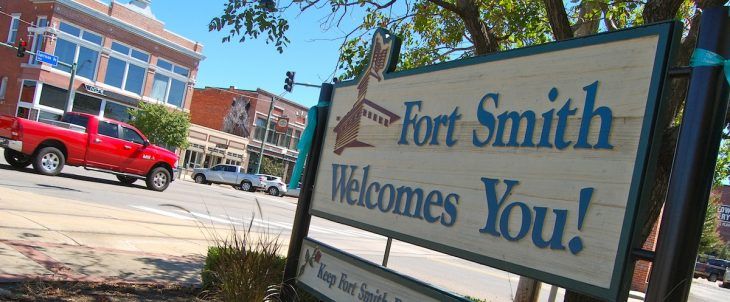CIP committee member, Fort Smith planning commissioner share concerns on Kelley Highway project
by May 24, 2018 6:20 pm 1,623 views

Plans on the Kelley Highway extension to Riverfront Drive are “about 80% complete,” according to Stan Snodgrass, engineering director for the city of Fort Smith. The project would create an easier path to the United States Marshals Museum (USMM) from I-540.
“We have it on our CIP (Capital Improvement Plan) for 2019-2020 to get right-of-way (purchases) and utilities (relocation), and then construction in 2021,” he said.
But not everyone at the CIP advisory committee meeting on Thursday (May 24) was happy with the estimated $15 million project. Committee member Robert Brown inquired about activities at the Fort Smith National Historic Site and Fort Smith Museum of History nearby and said he was told “they average about 50-75 people a day down there (at the Historic Site) — what’s that, 25 cars? The Fort Smith Museum (of History), they get maybe 10 cars a day. That’s average annualized.”
Brown continued: “If the Marshals Museum does flop, we’re still out the $15 million. It would be nice to have the Marshals Museum — if they’re going to have 1,000 cars, then yeah, let’s build a road. But if they’re going to have 100, why should we be out $15 million until we find out if it’s going to be successful or not?”
Richard Morris, a participant in Thursday’s citizens forum portion of the meeting and a city planning commissioner, advised against “jumping the gun” on the Kelley Highway extension, worried tourists could bypass the downtown area in favor of going directly to the Marshals Museum, calling it a “$15 million convenience” for “maybe 100 cars.”
“How many of those 100 cars are going to venture on beyond the Marshals Museum?” Morrison asked, adding that “after the Marshals Museum gets off the ground and proves itself, maybe do the extension later on. That way the planning won’t be for naught. But to jump right into it ahead of time just to make it a little bit more convenient, you’re cutting out the business people downtown, and you’re not getting the visibility.”
CIP committee member Stan Vlademar provided an alternate take, stating, “Sometimes we have to be visionaries, and we have to get out of our box and think about what’s going to happen 30 years down the road — not think of today, but think of what’s going on in 20 or 30 years when we’re not here.”
Snodgrass said the extension would take two years to complete for an estimated finish date of 2023, provided the Board of Directors continues to prioritize the project. The museum is slated to open Sept. 24, 2019, so it will have two years to, as Morris said, “prove itself” before the majority of the spending begins. The CIP calls for $4 million in project spending during 2021 and $8.7 million in 2022. The department spent $142,959 on the project in 2017 and estimates $163,000 for this year with $500,000 and $600,000 slated for 2019 and 2020, respectively.
Jim Dunn, president of the USMM Foundation, previously told Talk Business & Politics “conservative estimates” would place expected visitors to the Museum at between 115,000 and 120,000 per year, or just over 300 visitors per day.
“But that’s cyclical, and there will be very busy times when traffic will be much heavier,” Dunn said.
Addressing a point Brown made at a meeting in February regarding the museum having “multiple points of entry” without the Kelley Highway extension, Dunn explained that “If you drive those streets as compared with the extension of Kelley Highway, it’s dramatically different.”
“It’s easier to come down the Kelley Highway extension where it’s four-lane all the way with fewer stoplights,” Dunn said, adding that “you can’t have too much access to downtown and the riverfront.”
He continued: “We have to make it easy for people to come visit, and that’s much easier. It’s Ward 2, and there is very little going on in Ward 2, and if we can’t open that up to more traffic to get people in, then it’s going to seriously impede traffic and seriously impede our ability to do what we are trying to do right now.”
In January, Los Angeles-based design firm Thinkwell: The Experience Co. rolled out the schematic concepts for the five-part museum experience, and in late 2017, the museum made available a virtual reality tour from its current site on Riverfront Drive. As of February, the planned 50,000 square-foot facility had $19.7 million left to raise of its final $58.6 million goal.
